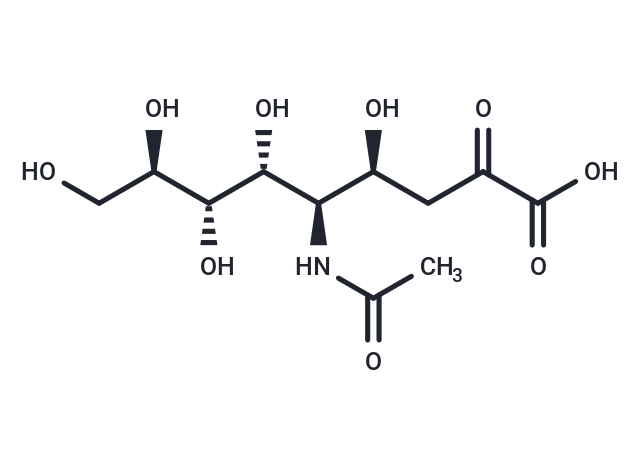Shopping Cart
- Remove All
 Your shopping cart is currently empty
Your shopping cart is currently empty

N-Acetylneuraminic acid (Acide aceneuramique) is a nine-carbon sialic acid monosaccharide commonly found in glycoproteins on cell membranes and in glycolipids such as gangliosides in mammalian cells. Studies have shown that N-Acetylneuraminic acid is biologically useful for neurotransmission, leukocyte extravasation, viral or bacterial infections, and carbohydrate-protein recognition.

| Pack Size | Price | Availability | Quantity |
|---|---|---|---|
| 100 mg | $48 | In Stock | |
| 1 g | $68 | In Stock | |
| 1 mL x 10 mM (in DMSO) | $45 | In Stock |
| Description | N-Acetylneuraminic acid (Acide aceneuramique) is a nine-carbon sialic acid monosaccharide commonly found in glycoproteins on cell membranes and in glycolipids such as gangliosides in mammalian cells. Studies have shown that N-Acetylneuraminic acid is biologically useful for neurotransmission, leukocyte extravasation, viral or bacterial infections, and carbohydrate-protein recognition. |
| Alias | NeuAc, Lactaminic acid, Acide aceneuramique |
| Molecular Weight | 309.27 |
| Formula | C11H19NO9 |
| Cas No. | 131-48-6 |
| Smiles | [C@H]([C@H]([C@@H]([C@@H](CO)O)O)O)([C@H](CC(C(O)=O)=O)O)NC(C)=O |
| Relative Density. | 1.3580 g/cm3 (Estimated) |
| Storage | store at low temperature | Powder: -20°C for 3 years | In solvent: -80°C for 1 year | Shipping with blue ice. | ||||||||||||||||||||||||||||||||||||||||
| Solubility Information | H2O: 125 mg/mL (404.18 mM), Sonication is recommended. DMSO: 27.5 mg/mL (88.92 mM), Sonication is recommended. | ||||||||||||||||||||||||||||||||||||||||
Solution Preparation Table | |||||||||||||||||||||||||||||||||||||||||
DMSO/H2O
H2O
| |||||||||||||||||||||||||||||||||||||||||

Copyright © 2015-2025 TargetMol Chemicals Inc. All Rights Reserved.